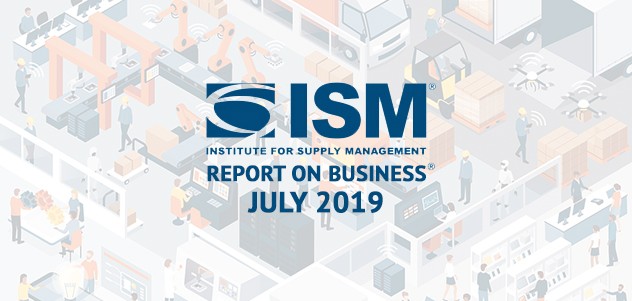The July 2019 Manufacturing ISM® Report On Business® Paints a Picture of Contraction

The July 2019 Manufacturing ISM® Report On Business® is out, continuing the creep of bad news for the manufacturing economy. Downward trends continue among key metrics, pushing the index closer to contraction territory. Headwinds continue to mount for manufacturing in general, and the markers for recession are becoming clearer by the month.
For the fourth straight month, the index slid closer to the threshold for contraction — down to 51.2% from 51.7% — and now skirts the barrier by a mere 1.2%. Another month of decline could very well mark the beginning of an official manufacturing recession.
More troubling than the overall PMI are the recent dips in individual economic markers driving it. Production saw tremendous retraction, down 3.3% to 50.8%, bringing it the closest it’s been in nearly three years to contraction. Imports similarly fell, losing 3.0% to officially fall into contraction territory after teetering on 50% just last month. The report for employment is just as grim, as the economy gave back all its gains since April 2019 (and more), falling to 51.7%.
Currently, six of the 10 variables contributing to total PMI are showing contraction, with the remaining four trending in the same direction.
Headwinds drive a harsh industrial climate
Now in our 10th year of a bullish economy, it’s not uncommon to see downtrend toward recession in specific sectors; however, the speed of contraction is giving economists and industrialists pause. In August 2018, the manufacturing PMI registered 60.8% — meaning economic outlook has fallen nearly 10% in the span of a year.
Industrial voices point to tariffs and the uncertainty they bring as the cause for swift downturn in 2019. President Trump has continued to levy tariffs against China, with another wave expected in September. With each levy, trade tensions rise, impacting importing and exporting of the manufacturing economy. Further clashes between the Trump administration and both Canada and Mexico have also shaken the industry and brought about uncertainty.
Another issue hampering the industry is outsourced labor. The growing skills gap and high cost of domestic manufacturing see companies outsourcing work to remain competitive.
New developments in the Federal Reserve’s decision to lower interest rates is also playing a role. Though done to protect the “record-long economic expansion from slowing global growth,” many economists believe the rate cut is a form of artificial buoyance. They feel manufacturing has already entered a recessionary period and that a rate cut may only make it worse.
The sun is setting on a record economy
The bullish manufacturing economy we’ve enjoyed for more than a decade is record-setting and not the norm. Slow regression to the mean isn’t surprising — especially not to industry executives. Many have anticipated the slowdown and acted accordingly.
“Weakness in end markets accelerating rapidly. Continuing to reduce production based on weakening demand and declining current orders.” (Chemical Products)
“The economy is holding steady. All the uncertainty seems to be priced in accordingly, and supply plans are consistent throughout 2019. Business conditions improving yet still facing headwinds in foreign exchange, commodities, and certain direct materials.” (Food, Beverage & Tobacco Products)
Contraction is inevitable, and contraction at the end of a 10-year cycle is far from worrisome. What is worrisome, however, is the quickness of contraction and the mounting headwinds setting up to drive manufacturing deeper into recession once it crosses the threshold.